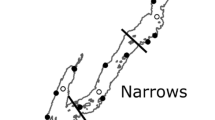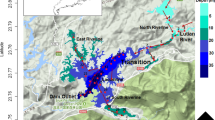Abstract
We examined horizontal spatial patterns of fish densities and zooplankton biomass at a fine spatial scale of 50 m across seasons before, during, and after an experimental lake destratification to determine how interacting trophic levels may respond to alteration of thermal stratification. We used semivariogram analysis to calculate maximum distances of autocorrelation for fish and zooplankton separately, and cross variograms to determine whether relationships between fish and zooplankton are positive or negative. Fish became more dispersed during the manipulation, likely due to a flight response with the loss of preferred cold water habitat. There were no changes in zooplankton horizontal distributions with mixing, but we detected seasonal trends in distribution and biomass. We detected positive relationships between fish densities and zooplankton biomass for portions of the year, but did not detect any negative relationships. There was no effect of lake mixing on spatial interactions between fish and zooplankton. Our results indicate that external factors, such as seasonal wind patterns, may drive whole-lake zooplankton distributions, and that fish respond horizontally to change in vertically structured processes, especially when reliant on depth-dependent variables such as cold water.





Similar content being viewed by others
References
Ahrenstorff TD, Hrabik TR, Jacobson PC, Pereira DL (2013) Food resource effects on diel movements and body size of cisco in north-temperate lakes. Oecologia 173:1309–1320
Appenzeller AW, Leggett WC (1992) Bias in hydroacoustic estimates of fish abundance due to acoustic shadowing: evidence from day-night surveys of vertically migrating fish. Can J Fish Aquat Sci 49:2179–2189
Lake District Bathymetry, North Temperate Lakes Long Term Ecological Research program (NTL-LTER) [online]. NSF, Center for Limnology, University of Wisconsin-Madison. http://lter.limnology.wisc.edu. Accessed 01 June 2015
Berman C.H., Quinn T.P. 1991. Behavioural thermoregulation and homing by spring chinook salmon, Oncorhynchus tshawytscha (Walbaum), in the Yakima River. J Fish Biol 39: 301–312.
Blukacz EA, Shuter BJ, Sprules WG (2009) Towards understanding the relationship between wind conditions and plankton patchiness. Limnol Oceanogr 54:1530–1540
Breau C, Cunjack RA, Peake SJ (2011) Behavior during elevated water temperatures: can physiology explain movement of juvenile Atlantic salmon to cool water? J Anim Ecol 80:844–853
Brentnall SJ, Richards KL, Brindley J, Murphy E (2003) Plankton patchiness and its effect on larger-scale productivity. J Plankton Res 25:121–140
Brooks JL, Dodson SJ (1965) Predation, body size, and composition of plankton. Science 150:28–35
Dodson S I (1990) Predicting diel vertical migration of zooplankton. Limnol Oceanogr 35:1195–1200
Durance I., Lepichon C., Ormerod S.J. (2006). Recognizing the importance of scale in ecology and management of riverine fish. River Res Applic 22:1143–1152.
Environmental Systems Research Institute (ESRI) [online]. ArcGIS Pr (2015) Understanding a semivariogram: the range, sill, and nugget. Available from http://www.pro.arcgis.com. Accessed 24 June 2015
Ferguson RG (1965) Bathymetric distribution of American smelt Osmerus mordax in Lake Erie, vol 13. University of Michigan, Great Lakes Research Division Publication, pp 47–60
Folt CL, Burns CW (1999) Biological drivers of zooplankton patchiness. Trends Ecol Evol 14:300–305
George DG, Winfield IJ (2000) Factors influencing the spatial distribution of zooplankton and fish in Loch Ness, UK. Freshwater Biol 43:557–570
Great Lakes National Program Office (GLNPO) (2003) Standard operating procedure for zooplankton analysis. Grace Analytical Labs
Hanski I (1981) Coexistence of competitors in patchy environment with and without predation. Oikos 37:306–312
Hastings A (1988) Food web theory and stability. Ecology 69:1665–1668
Holbrook BV 2011. Spatial and temporal variability in zooplankton-fish interactions in freshwater communities. PhD Dissertation, Department of Biology, University of Minnesota Duluth, Duluth MN
Hrabik TR, Magnuson JJ, McLain AS (1998) Predicting the effects of rainbow smelt on native fishes in small lakes: evidence from long-term research on two lakes. Can J Fish Aquat Sci 55:1364–1371
Hrabik TR, Jensen OP, Martell, S. J. D., Walters CJ, Kitchell JF (2006) Diel vertical migration in the Lake Superior pelagic community. I. Changes in vertical migration of coregonids in response to varying predation risk. Can J Fish Aquat Sci 63:2286–2295
Isaac EJ, Hrabik TR, Stockwell JD, Gamble AE (2012) Prey selection by the Lake Superior fish community. J Great Lakes Res 38(2):326–335
Krebs JR 1978. Optimal foraging: decision rules for predators. Behav Ecol 22–63
Lathrop RC, Johnson BM, Johnson TB, Vogelsang MT, Carpenter SR, Hrabik TR, Kitchell JF, Magnuson JJ, Rudstam LG, Stewart RS (2002) Stocking piscivores to improve fishing and water clarity: a synthesis of the Lake Mendota biomanipulation project. Freshwater Biol 47:2410–2424
Lampert W (1989) Adaptive significance of diel vertical migration in zooplankton. Functional Ecol 3: 22–27.
Lantry BF, Stewart DJ (1993) Ecological energetics of rainbow smelt in the Laurentian Great Lakes: an interlake comparison. Trans Am Fish Soc 122:951–976
Lawson ZJ, Vander Zanden MJ, Smith CA, Heald E, Hrabik TR, Carpenter SR (2015) Experimental mixing of a North-Temperate lake: Testing the thermal limits of a coldwater invasive fish. Can J Fish Aquat Sci 72(6):926–937
MacPhee S, Arnott SE, Keller WB (2011) Lake thermal structure influences macroinvertebrate predation on crustacean zooplankton. J Plankton Res 33:1586–1595
Magnuson JJ, Kratz TK, Benson BJ (eds.). 2006. Long-term dynamics of lakes in the landscape: long-term ecological research on north temperate lakes. Oxford University, Oxford
Neumann RM, Willis DW (1996) Application of relative weight (Wr) as a tool for assessment of esocid populations. In: R. Soderberg (ed.) Warmwater Workshop Proceeding: Esocid management and culture. 21–28. Mansfield University, Mansfield
North Temperate Lakes Long Term Ecological Research program (NTL-LTER) [online]. Available from http://lter.limnology.wisc.edu. NSF, Center for Limnology, University of Wisconsin-Madison
Parker-Stetter SL, Rudstam LG, Sullivan PJ, Warner DM (2009) Standard operating procedure for fisheries acoustics in the Great Lakes. Great Lakes Fishery Commission. ISSN 1090–1051.
Pastor J, Dewey B, Moen R, Mladenoff DJ, White M, Cohen Y (1998) Spatial patters in the moose-soil ecosystem on Isle Royale, Michigan, USA. Ecol App 8(2):411–424
Pinel-Alloul B (1995) Spatial heterogeneity as a multiscale characteristic of zooplankton community. Hydrobiologia 300–301:17–42
Ragotzkie RA, Bryson RA (1953) Correlation of currents with the distributions of adult Daphnia in Lake Mendota. J Mar Res 12:157–172
Read JS, Shade A, Wu CH, Gorzalski A, McMahon KD (2011) “Gradual Entrainment Lake Inverter” (GELI): a novel device for experimental lake mixing. Limnol. Oceanogr. Methods 9:14–28
Rinke K, Huber, A.M.R., Kempke S, Eder M, Wolf T, Probst WN, Rothhaupt K-O (2009) Lake-wide distribution of temperature, phytoplankton, zooplankton, and fish in the pelagic zone of a large lake. Limnol Oceanogr 54:1306–1322
Rivoirard J, Simmonds J, Foote KH, Fernandez P, Bez N. 2008. Geostatistics for estimating fish abundance. Blackwell and Sons Science Inc
Robinson CJ, Pitcher TJ (1989) Hunger motivation as a promoter of different behaviours within a shoal of herring: selection for homogeneity in fish shoal? J Fish Biol 35:459–460
Rose GA, Leggett WC (1990) The importance of scale to predator–prey spatial correlations: an example of Atlantic fishes. Ecology 71:33–43
Rovinsky AB, Adiwidjaja HM, Yakhnin VZ, Menzinger M (1997) Patchiness and enhancement of productivity in plankton ecosystems due to the differential advection of predator and prey. Oikos 78:101–106
Sih A (1984) The behavioral response race between predator and prey. Am Nat 123:143–150
Simmonds J, MacLennan DN (2006) Fisheries acoustics: Theory and practice, 2nd edn. Chapman and Hall. London.
Sommer U, Gliwicz ZM, Lampert W, Duncan A (1986) The PEG-model of seasonal succession of planktonic events in fresh waters. Archive for Hydrobiology 106:433–471
Stanton TK, Chu D, Wiebe PH, Martin LV, Eastwood RL (1996) Sound scattering by several zooplankton groups. I. Experimental determination of dominant scattering mechanisms. J Acoust Soc Am 103(1):225–235
Tessier AJ, Welser J (1991) Cladoceran assemblages, seasonal succession and the importance of a hypolimnetic refuge. Freshwater Biol 25:85–93
Tessier AJ, Woodruff P (2013) Cryptic trophic cascade along a gradient of lake size. Ecology 83:1263–1270
Thackeray SJ, George DG, Jones RI, Winfield IJ (2004) Quantitative analysis of the importance of wind-induced circulation for the spatial structuring of planktonic populations. Freshwater Biol 49:1091–1102
Turner MG (2001) Landscape Ecology: In Theory and Practice. Springer-Verlag, New York et al.
Vanderploeg HA, Pothoven SA, Fahnenstiel GL, Cavaletto JF, Liebig JR, Stow CA, Nelpa TF, Madenjian CP, Bunnell DB (2012) Seasonal zooplankton dynamics in Lake Michigan: Disentangling impacts of resource limitation, ecosystem engineering, and predation during a critical ecosystem transition. J Great Lakes Res 38:336–352
Ware DM, Thomson RE (2005) Bottom-up ecosystem trophic dynamics determine fish production in the Northeast Pacific. Science 308:1280–1284
Wetzel RG 2001. Limnology. Academic Press
Wismer DA, Christie AE 1987. Temperature relationships of Great Lakes fishes: a data compilation. Great Lakes Fish. Comm. Spec. Pub. No. 87–3. Ann Arbor, Mich
Acknowledgements
We thank all those who have contributed to this large-scale project throughout years of its development and implementation. We thank the entire staff of UW-Trout Lake Field Station for housing researchers during field seasons and for providing sampling equipment and insightful advice. We especially thank Tim Kratz for his key role in logistics. Without his work this project would not be possible. Several field assistants also played key role in data collection: Colin Smith, Jamie Dobosenski, Page Mieritz, Paul Schramm, Tom Thalhuber, Ian Harding, Matt Pawlowski, Avery Koblings, Weston Matthews, Jon Celmer, Ellen Heyn, and Sarah Jones-Witthuhn. Finally, we thank the anonymous reviewers who took the time to provide thorough comments and suggestions, which vastly improved our manuscript. This study took place at the University of Wisconsin-Madison Trout Lake station. Funding for this project was provided by a private donation to the University of Wisconsin-Madison, an A.W. Mellon Foundation award to S.R. Carpenter, the North Temperate Lakes LTER program (NSF grant DEB 0822700), and a Wisconsin Department of Natural Resources AIS grants (ACE1-084-10, ACE1-121-12, ACE1-141-13) to M.J. Vander Zanden.
Author information
Authors and Affiliations
Corresponding author
Appendix
Appendix
See Figs. 6, 7 and Tables 2, 3 and 4.
Rights and permissions
About this article
Cite this article
Emily, H., Hrabik, T.R., Li, Y. et al. The effects of experimental whole-lake mixing on horizontal spatial patterns of fish and Zooplankton. Aquat Sci 79, 543–556 (2017). https://doi.org/10.1007/s00027-016-0516-x
Received:
Accepted:
Published:
Issue Date:
DOI: https://doi.org/10.1007/s00027-016-0516-x






